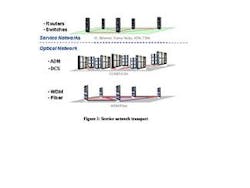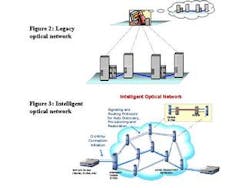The intelligent optical network: The new foundation for competitive networks
With the industry downturn, maintaining or restoring profitability is clearly the primary objective of each telecommunications service provider.
By JIM ARCHULETA
CIENA Corp.
The telecom downturn has resulted in a widespread shift in the business objectives of the industry. Where geographic coverage and capacity were key objectives during the industry boom, profitability is now the critical element to success and has become imperative to survival.
Despite the industry downturn, increasing traffic demand continues, with corporate usage consistently on the rise and consumer broadband now mainstream. In this new era of the telecom industry, innovation must be focused on improvements that impact the bottom line, and carriers must walk the fine line of supporting growth with minimal incremental cost.
In searching for new opportunities inspired by profitability, the optical network is a great place to start. As the supporting infrastructure for nearly all carrier communication services, optical infrastructures provide bandwidth and restoration in support of voice, data, and Internet service networks (see Figure 1). Efficiencies delivered to the optical backbone impact profits across the entire line of business.
A carrier optical network infrastructure consists of fiber, a WDM sub-layer and a SONET/SDH layer. The fiber and WDM layers handle the transport function; with fiber serving as the transport medium and WDM enabling increased transport density by optically multiplexing communication signals via differentiated optical frequencies, known as wavelengths, which interconnect SONET/SDH devices.
The SONET/SDH layer, comprised of add/drop multiplexers (ADMs) and digital crossconnects (DXCs), enables traffic to be directed, managed, and protected in a variety of coverage topologies served by a rich set of operations, administration, maintenance and provisioning (OAM&P) capabilities. All of this ensures carrier-class network performance and availability.
Generally, ADMs enable traffic to be added and dropped from SONET/SDH rings while DXCs interconnect rings to provide interconnected network transport architecture. As networks grew to support data traffic, telecom service providers continued to deploy massive amounts of ADMs and crossconnects to deal with the traffic growth, but only at a considerable cost.
Today, telecommunications service providers face a serious architectural dilemma. Their networks were initially designed and optimized for circuit-mode services, such as voice-over-TDM and data-over-private-line, which contribute approximately 80% of their revenue. Carriers must, therefore, continue to provide these vital circuit-mode services, with the high reliability and inherent quality-of-service (QoS) to which their customers have become accustomed.
However, their networks must also cope with the deluge of packet-mode traffic caused by the growth of the public Internet, e-mail, multimedia services, and corporate local area networks (LANs) and wide area networks (WANs) interconnected with virtual private network (VPN) services.
By most industry estimates, nearly all of the traffic growth in the industry is fueled by these and other data traffic applications. To remain competitive, service providers must adapt their networks to carry this packet-mode traffic with an architectural approach focused on optimization of network efficiency and streamlined management.
Legacy optical networks
To date, optical networks have undergone two stages of evolution. The first stage occurred in the 1988-1995 period with the adoption of SONET/SDH standards and the large-scale installation of fiber in long haul and metropolitan area networks. The second stage began around 1995 with the advent of WDM, initially with four wavelengths per fiber and now with more than 96 wavelengths per fiber.
These first two stages constitute what may be termed the era of "legacy optical networks," characterized by systems that adequately perform the basic WDM and SONET/SDH functions, but without mature and integrated management capabilities. Within a typical legacy optical network, the network elements can carry data at extremely high speeds, but management systems are limited to baseline management and provisioning functions (see Figure 2).
Legacy optical networks that support network backbones suffer from inflexibility and high operating expenses due to the inherent limitations built into legacy equipment and network management architectures. Inventory management is still based on decades-old, top-down systems with manually entered records, which can be outdated and full of errors.
Provisioning an end-to-end connection is, therefore, a manually intensive, slow process that may take weeks or months to complete and, additionally, may require coordination between several vendor-specific management systems. But the processes of network configuration and service provisioning is operationally expensive, forcing these functions to be performed manually with segment-by-segment interconnection, making them slow, pricey, and prone to additional human error.
As a second limitation, the channels employed by traditional SONET/SDH networks are of fixed size (such as OC-3, OC-12, OC-48 and OC-192), and their protection schemes (such as linear and ring) are static--that is, they must be determined during network design and circuit assignments. These factors limit the network's flexibility to provide anything but highly resource-intensive ring protection that reserves high volumes of network capacity for protection. In fact, with the growth of data traffic, new alternatives to protection that can leverage shared-protection capacity can still meet the restoration needs of today's network at a much lower transport cost from lower protection bandwidth reservation.
Finally, the legacy network requires every action to flow through the central network management system (NMS), which limits the scalability and manageability of the network. Also, whenever interface cards are added or removed, the database in the NMS must be manually updated, making it difficult and expensive to maintain its integrity. This limitation of the central NMS results in long repair times by making it difficult to correlate alarms and identify the root cause(s) of a fault.
Overcoming limitations
The major reason for the limitations of the legacy optical network is the inflexibility and limited functionality of its hardware and software. Today, the industry is adopting a solution to this problem--the introduction of more flexibility into the network to automate management and provisioning and to streamline costly slow and manual processes.
Today, network architectures are being transformed with the introduction of high-density next generation optical network systems comprised of optical switches (which combine ADM and DXC functionality with much higher density) and the DWDM systems they interconnect. Together, these systems dramatically lower capital and facilities costs by providing much greater capacity in terms of traffic support. But there are other benefits as well.
These savings are now complemented by the introduction of software-based intelligence, which enables service providers to dramatically streamline administration and management of optical network backbones. By introducing advanced signaling and routing protocols and processing power to network elements (see Figure 3), carriers can automate key backbone administration and management functions. With the addition of this intelligence, the optical network can deliver efficiency and streamlined management.
The impacts of distributed intelligence can be far reaching. With intelligence the network can auto-discover network elements, resulting in simplified network configuration, simplified inventory management, and automatic reconfiguration when network elements are added to the backbone. When service is provisioned, intelligence can ensure optimized routing, as the intelligent network can determine the most efficient path selection based on service-layer route and restoration requirements.
By leveraging signaling protocols, the intelligent optical network can even support dynamic provisioning, which can drive connection times to seconds. Finally, network usage can be made more efficient by leveraging mesh restoration, which allows shared protection resources. This provides economic alternatives to traditional ring-based restoration methods that mandate dedicated protection capacity for all working traffic. By leveraging intelligence, carriers can optimize the network to provide the most efficient support of services, with bandwidth and restoration that closely matches the requirements of their service networks.
This efficiency leads to higher profitability in carrier network services. Savings can be realized across all services, so carriers can have the flexibility to enjoy higher margins and compete more effectively in the marketplace.
The industry is now embracing intelligent optical networking technologies. Standards bodies are defining standards for intelligent optical networking, with the 2001 ratification of the optical user-to-network interface (UNI) by the Optical Internetworking Forum (OIF), the Internet Engineering Task Force (IETF) ratification of general multi-protocol label switching (GMPLS) expected this year and the International Telecommunication Union - Telecommunication (ITU-T) definition of automatic switched optical network (ASON) expected in early 2003.
In the meantime, leading service providers have made the leap into intelligent optical network systems. Those that move forward are recognizing the economic benefits in the near term, resulting in potentially higher profitability that will ensure healthy cost structures in the years ahead. Service providers today must adapt their networks to support the ongoing growth of data traffic without jeopardizing circuit-mode services, such as TDM voice, that still bring in significant revenues.
Previous attempts to perform this balancing act have led to high capital and operational costs and rapid technology obsolescence because these efforts tried to extend outdated legacy optical network technologies without introducing the efficiency and flexibility that intelligent systems can deliver. The solution to this dilemma is to implement an intelligent optical network with a new architecture that reduces these high costs and plays a significant role in restoring service provider profitability in the years ahead.
Jim Archuleta is senior manager of applications marketing for CIENA Corp., headquartered in Linthicum, MD. He may be reached via the company's Web site at www.ciena.com.
Figure 2: Within a typical high-speed legacy optical network, management systems are limited to baseline management and provisioning functions


